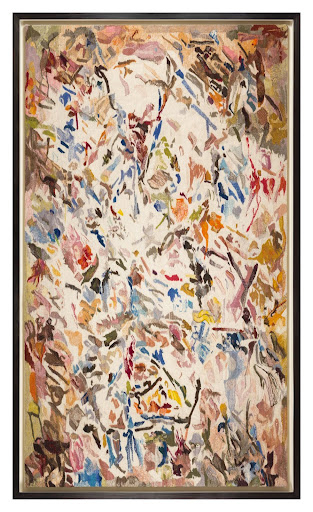Inspired by L'Ancêtre (The Ancestor) 69-71 Oil on canvas by Ernest Ngungunyane Methuen Mancoba
| CCAC #: | 0470 |
| Artwork title: | Inspired by L'Ancêtre (The Ancestor) 69-71 Oil on canvas by Ernest Ngungunyane Methuen Mancoba |
| Artist(s): |
Joseph Ndlovu |
| Year made: | 2016 |
| Artwork type: | Textile |
| Medium: | Fibre |
| Dimensions (mm): | 290 x 162.3 |
| Source: | Donated by the Arts & Ubuntu Trust |
| Year acquired: | 2017 |
| Installation type: | Movable artwork |
| Current location: | In storage |
| Signage: | This woven work is based on Ernest Mancoba's (1904–2002) painting L'Ancêtre, seemingly abstract but rich in depth. L'Ancêtre pays tribute to Mancoba's ancestry as well as to the heritage of South Africa, the artist's land of birth. Mancoba drew inspiration for this work from a story his mother, Florence Mancoba, devoted keeper of her family's history, told him about his great-grandmother. According to Elza Miles, this story left an indelible impression on Mancoba: "When the Mfengus could not come to terms with the despotism of King Shaka (c. 1787-1828) they searched for and found a new home among the Xhosas in the Transkei. There they, who called themselves 'destitute wanderers', made a success of cattle farming. Among the Mfengus who fled with the Zulu forces in hot pursuit was the Mangquangwanas, Mancoba's maternal kin. In their group was an aged great-grandmother. She was so old and weak that the younger members had to carry her. When after a few days she realised that she was an impediment to the flight of her people, and that the distance between her and her pursuers was decreasing, she ordered them to leave and to proceed without her. It was in Mancoba's modest flatlet – bed-cum-living room – in Paris on the evening of 15 September 1990 when the artist recalled this significant moment in his family's history. In conclusion he said: 'She stood and they walked. She waved and she waved. It was the last they saw of her... because she saw that she hindered quicker, practical progress. So she sacrificed herself.' In the room followed a moment's reverent silence. Then a deeply touched listener whispered and pointed to the painting in the corner above the artist's bed: 'Ernest, there she is.' Solemnly the artist replied: 'Tak' (Danish for thank you)." Mancoba, who left South Africa for Europe in 1938, very seldom gave illustrative titles to his pieces, L'Ancêtre being one of the few exceptions. He added the title when the Johannesburg Art Gallery acquired the work for its permanent collection. The Arts and Ubuntu Trust recognised that this work could translate well into a tapestry, on the advice of Stephan Welz and Sokhaya Charles Nkosi, and this is why Ndlovu was commissioned to create this woven piece. Justices Sachs and Mokgoro also commissioned Ndlovu to produce the very first artwork of the CCAC, Humanity (1995). The weaving of L'Ancêtre was the final artwork he completed before falling ill. Mancoba commented that the lines and colours he used for his work, closely mimicked by Ndlovu, came directly from his subconscious without deliberate intervention in a manner that he described as "almost Freudian". Correspondingly, the final meaning is that which develops in the consciousness of the viewer. "Once the image begins to speak to you, then the message is there," Mancoba said. |

Photographer: Dragontree
Photo copyright: CCT
Related artwork: Reading the Ancestor
Related webinar: ‘African spirituality, humanity’s heritage’
NOTE: The process of photographing artworks in the CCAC is underway - we are currently working to improve image quality and display on the CMS but have included internal reference photos for identification purposes in the interim.